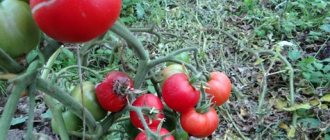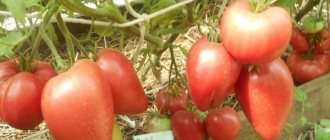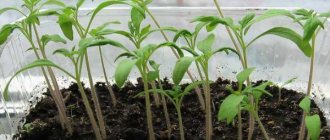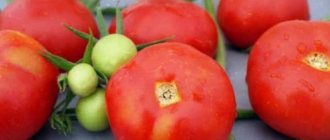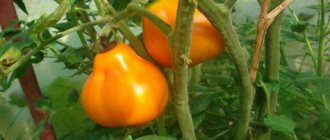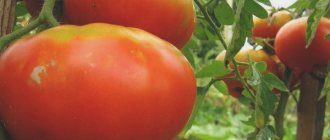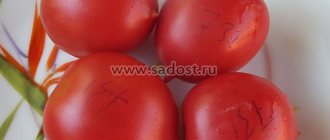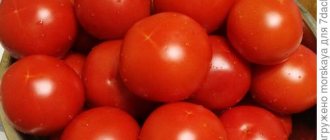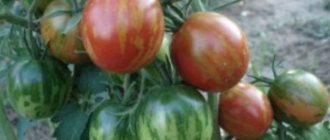Characteristics of the Dubok tomato
The variety was bred back in the days of the Soviet Union for cultivation on the ground in the open air of Moldova, Ukraine and southern Russia. Some lovers of year-round consumption of their tomatoes grow this tomato variety on the windowsill.
Tomatoes "Dubok"
Tomato has the following characteristics:
- bush of the variety is undersized, standard, height – 40-60 cm;
- the period from germination to harvest is 85-105 days;
- the fruits are round, juicy and fleshy. The weight of one fruit is 100-200 g;
- productivity – 7 kg per 1 sq.m;
- sowing for seedlings is done in March, planting seedlings - May-June, harvest period - July-August;
- The bush is stocky and powerful, from a distance it resembles a potato bush.
Harvesting
The weight difference of one vegetable is 60-130 grams. The average yield is 2-5 kg per bush. By freeing up a space of 30-40 cm for the plant, you can expect a consistently high yield. In case of untimely planting or unfavorable weather conditions, this tomato will not make you worry about its immaturity, since even if picked brown, it can arrive in a few days (3-4).
General information
This variety was obtained already in the new century. Breeders have endowed “Dubok” with a number of positive qualities, although the tomato is not a hybrid. That is, its seeds can also be planted after 1-2 years, and their productivity and harvest quality will not decrease. The beauty of “Dubok” tomatoes is their low growth and the absence of the need for pinching. This all saves energy and time.
The “Oak” variety is often used for growing at home on a windowsill. It produces good fruit, but pollination must be done by hand.
The variety loves well-moistened soil so that the roots of the bushes can develop. As for the soil, tomatoes prefer sand, fertile soil with good air permeability. The variety pleases with its early ripening, and pests and diseases do not bother the Dubok tomato. Further details and description of the variety.
Advantages of the variety
When it comes to advantages, Dubka has a lot of them:
- It ripens earlier because peduncles and racemes are formed through fewer leaves, and fruit ripening occurs earlier than in indeterminate varieties.
- Increased productivity, based on the fact that flower set occurs in a larger volume.
- Simultaneous ripening of several clusters, since, being determinant, the Dubok tomato is able to set them.
- Excellent indicators of unpretentiousness to storage conditions and shelf life.
Advantages and disadvantages of the variety
The Dubok tomato, despite its early ripening, surpasses many mid-ripening varieties in terms of yield. Advantages of the variety:
- early ripening;
- excellent tomato taste;
- keeping quality of fruits;
- suitability for transportation;
- compactness of plants;
- cold resistance;
- ease of care.
Early ripening tomatoes produce a good harvest and do not require the removal of shoots. The fruits in clusters ripen at the same time, and when optimal conditions are created, they are stored for a long time. The variety is attractive to those who grow tomatoes for sale. Dubok tomatoes tolerate transportation well and do not lose their presentation or taste.
The versatility of the fruit is also an advantage. In the description of the advantages, it should be noted that the variety is appreciated by gardeners who have modest-sized plots. It is possible to plant a large number of bushes in the beds without losing productivity.
The characteristics and description of the variety will be incomplete without highlighting the huge “plus” - disease resistance. This variety is also less susceptible to pests. But when growing in open ground, we must not forget about prevention. Seed material is collected from tomato fruits and used for sowing for the next season.
What are the disadvantages of Dubka? These tomatoes do not tolerate sudden temperature changes particularly well, and this is their only “minus”.
The nuances of growing in a greenhouse
Since Dubok tomatoes are low-growing, they are recommended to be grown in open ground .
They are also suitable for greenhouses, but in a favorable climate this is simply not necessary. Greenhouses are a more suitable option for growing these tomatoes in northern regions. Gardeners claim that the variety grows faster in closed ground. At the same time, there are fewer fruits on the bushes , but their volume exceeds the mass of those grown in open beds.
It is important to ventilate greenhouses well when growing these tomatoes in them and regularly loosen the soil - plants love air.
Tillage in the greenhouse must be thorough. It is better to completely replace the soil that was in place before planting tomatoes, since it is in greenhouses that various diseases rapidly develop.
Further care
In order for the Dubrava tomato variety to meet all expectations and produce a high-quality harvest, you must follow all the rules for caring for the crop.
Watering and fertilizing mode
Water the Dubrava tomato bushes 1-2 times a week with warm water under each bush directly onto the surface of the root system. In rainy weather, avoid the procedure; excess moisture can provoke the development of late blight.
The culture is responsive to fertilizing. It is recommended to fertilize once every 20 days using the following nutritional composition:
- 250 g wood ash;
- 50 g superphosphate;
- 1/5 of the total volume of manure;
- 10 liters of water.
Also, to speed up growth, feed the plants with nitrogen fertilizers.
Weeding beds
One of the measures for caring for the Dubrava tomato variety is loosening the beds, which must be done after each watering. The first time you should loosen the soil deep enough to 10–12 cm. This will create air permeability of the soil and comfortable conditions for warming up and enriching with oxygen, which is necessary for the roots of the plant, especially at the initial stage of the growing season. Subsequent loosening should be carried out to a depth of 5 cm. It is also necessary to prevent soil compaction in a timely manner, after rains and during drought.
Garter and shaping
The oak grove does not need to be tied up, since the crop is a low-growing variety. But by following this procedure, you can simplify care, get clean fruits, since they will not touch the ground, and the trunk will not break as it grows and under the weight of the vegetables. When positioned vertically, the tomato bush is better illuminated and the crop ripens faster.
Disease and pest control measures
The average resistance of Dubrava tomatoes to diseases requires a full range of protective measures. For prevention, it is necessary to treat the bushes with fungicides once every 20 days, as well as mulch and drip watering.
At the first symptoms of late blight, you can resort to chemical, as well as folk methods, using soda or vinegar. Among the harmful insects, the mole cricket is a serious danger to the crop. Since, moving under the ground, it damages the roots, which leads to the death of seedlings. Insecticides will help in the fight against it.
Outdoor care
Dubrava tomatoes are unpretentious; even an inexperienced gardener can safely take on their cultivation. The agricultural technology of the variety is very simple, but it has some nuances.
Latest entries Indoor plants that can bloom into trouble Why is it dangerous to plant “mother-in-law’s tongue” on your windowsill Folk ways to acidify the soil and thereby increase its fertility
Watering and weeding
The variety does not need to be watered frequently, but you will have to monitor the soil moisture to prevent severe drying out in the area of the root system. Unlike other varieties, Dubrava can even withstand waterlogging of the soil. But still, it’s not worth the risk; the soil under the bush should be in a moderately moist state, which mulch will help maintain. The next day after watering, light loosening should be done to maintain normal access of oxygen to the roots.
Dubrava tomatoes prefer moderately moist soil
During the growing season, it is necessary to carry out at least 3 weedings, which will free the rows from weeds. In addition, clean soil is the key to plant health.
In clean beds and the harvest pleases
Top dressing
Frequent feeding can provoke the growth of green mass and reduce the ability to form ovaries. Therefore, you should refrain from applying excessive nitrogen.
- The first feeding is carried out 2 weeks after transplanting into the ground. To do this, add 25 g of superphosphate, 5 g of urea and 6 - 10 g of potassium salt per 1 m².
- When fruits begin to set, treat the plant with organic matter. One plant uses 0.8 liters of mullein solution or bird droppings. You can use wood ash - 100 g per 1 m².
What signs can be used to determine a lack of microelements - table
| Microelement | Symptom |
| Nitrogen | The leaves become small, chlorotic, the veins acquire a light red tint. |
| Zinc and magnesium | Gray-bronze spots appear on the leaf plate |
| Iron | The foliage turns yellow with a whitish tint. |
| Potassium | The edges of the leaf blade curl and turn yellow-brown |
| Phosphorus | Tomatoes are stunted and wither, necrotic spots appear on the leaves |
Tomato leaves will tell you which microelements the crop lacks
Garter and shaping
The peculiarity of the Dubrava variety in not forming stepsons will save the gardener from unnecessary labor. To increase productivity, the bush is formed from 3 – 4 shoots.
The low stature allows the variety to be grown without trellises or supports. But still, when the plant begins to bear fruit, it is better to tie it up so that the clusters with the filling fruits do not break.
Dubrava tomatoes are low-growing, but during the ripening of the crop it is better to tie the clusters with fruits
How to grow tomatoes
Before planting seedlings in the ground, the soil on the site must be dug up and all weeds with roots must be removed. Be sure to apply organic and mineral fertilizers. Seedlings are planted in the beds when the ground has warmed to a depth of 15 cm.
Both sandy and loamy soil are suitable for tomatoes, into which nitrogen and potassium fertilizers are applied in the spring. The rules of crop rotation will help you choose the right area for tomatoes: it is recommended to plant them in beds where zucchini, onions, cucumbers, carrots, cabbage, and herbs previously grew. The place where representatives of the nightshade family previously grew is not suitable.
Hardened seedlings are transplanted into the ground, 3-4 bushes per 1 square meter. m. They loosen, weed and hill up every 2 weeks. For the first time after transplantation, it is recommended to protect the plant from sunlight, for example, with burdock leaves. Water the crop at the root and as needed.
Compliance with the following rules for planting tomatoes in the ground will help young plants quickly take root in outdoor conditions, which will ensure successful further growth and development:
- Water the pre-made holes with a manganese solution to disinfect the soil and further protect the fruits from infections.
- Plant the crop so that the first pair of leaves rises 2-3 cm above the ground. This will allow the root system to grow, receiving the required amount of fertilizer and oxygen.
- For the first 8-10 days, seedlings do not need watering.
- If necessary, shade the seedlings from the scorching sun.
- Start forming bushes only when new leaves appear, cutting off excess shoots and leaving 2 or 3 stems. This has a good effect on the fruiting of the crop.
If you want to get the harvest early, the bushes are pinched and the plant is formed into one stem. When forming a bush into 2 stems, the stepsons are removed from the three lower axils, when forming into 3 stems - from the two lower ones.
A prerequisite at the time of pollination is to maintain the temperature no higher than 25°C, otherwise pollination will not occur. It is necessary to be vigilant from the beginning to mid-May. In unfavorable conditions, use film shelters.
The crop does not need gartering, as the variety is low-growing. But tied bushes have their own advantages, the main one being that vegetables do not touch the ground and do not suffer from rot. At the same time, the integrity of the bush is not compromised: it does not break from its own weight.
When breeding low-growing tomatoes, nitrogen-containing fertilizers are applied once during fruit formation. Phosphorus and potassium are needed by the crop throughout the growing season. They are fed once every 2 weeks.
Diseases and pests
The average resistance of the plant to diseases indicates the need for regular preventive measures.
These include chemical treatment, mulching, and drip irrigation. For prevention, systemic-contact fungicides are used: Ditan M-45, Quadris 250. The frequency of preventive treatment is once every 20 days. When a crop is damaged by late blight, both chemical and traditional methods can be used to save the plant. Chemical treatments include treatment with Furacilin, and traditional treatments include soda or vinegar. Furacilin solution is prepared simply: 10 tablets per 10 liters of water. Spray before the flowers appear, at the first ovaries, at the first fruits. Spray with soda solution every week, dissolving 1 tablespoon of soda in half a bucket of water.
Mulching and fragrant herbs protect against insects living underground. The main land pest is the mole cricket. Moving underground, it damages the root system, as a result of which the seedlings die. Chopped cloves of garlic and fish heads also work well against mole crickets if you bury them in the beds.
Treatment with insecticides 1 month before fruiting will protect the plant from tomato mites. Among other things, for prevention purposes it is necessary to regularly inspect the bushes for the presence of pests from the insect world.
If tomatoes are planted in a greenhouse, do not forget to ventilate it regularly.
How to grow
Gardeners in the southern outskirts plant seeds directly in the soil in early spring, covering it with film. As soon as the seedlings appear, the film is replaced with a light covering material stretched over arcs. This is how the “oak trees” wait out the vagaries of spring. Reviews from gardeners about this method of growing are positive. And the majority note that such “oak grove” is stronger than tomatoes grown indoors.
In other regions, oak tomatoes are first germinated at home using the seedling method. To do this, prepare any containers in advance: plastic jars, cups, peat pots. After some time, the seeds will germinate, the roots will get stronger and you can safely move the plants to an open ground bed.
Basic rules for sowing seeds:
- Initially, soak the seeds in weak potassium permanganate, then dry. Prevention will help avoid many diseases.
- Sow seeds only in fertilized soil.
- Seeds for seedlings are sown on average across regions in the third ten days of March to a depth of no more than 15 mm.
- In the room where the seedlings are located, the air temperature is about 21-24 degrees.
- After two or three permanent leaves appear, the seedlings are pruned.
- Before transferring to open ground, mineral fertilizers are applied to the soil twice.
For relocation to the garden, the plants are prepared two weeks in advance - they begin to harden the seedlings:
- they are exposed to an open window, first for half an hour to an hour, and then the “oaks” are left to sunbathe in the open air for longer and longer;
- walks are extended to periods of “early morning-late evening”, accustoming them to daily temperature changes.
If possible, it is easier to move the seedlings to an open loggia or unglazed balcony.
To obtain a bountiful harvest in a greenhouse, it is necessary to provide each specimen of the “oak” variety with a living space of 30x40 cm. It is not recommended to thicken the planting of seedlings.
A few days after planting the seedlings in the garden, a single yellowing of some leaves occurs
They can be carefully removed to concentrate the bush's nutrition on healthy areas
Further care is similar to other determinate varieties.
Winter preparations
The quality of the pulp of this variety is somewhat dry and hard, making it perfect for winter preparations:
- in the form of lecho, tomato and tomato paste,
- pickling and salting,
- vegetable salads.
Growing tomatoes in open ground, the Dubok variety will be a success even for a beginner in gardening, and even more so if you have even a small greenhouse. Experienced gardeners claim that it can be grown even indoors on a windowsill.
Characteristics of the Dubok tomato
It is also a standard early-ripening variety, characterized by short stature. From the photo, the bushes at the beginning of fruit formation are almost identical. The variety is not a hybrid. The period from planting to harvesting of fruits is 85-105 days.
Tomatoes Dubok description of the culture and its features:
- The bushes are very compact, strong and powerful, with a moderate number of leaves, have little branching, and are 35-60 cm in height.
- The shape of the bushes is similar to potato bushes, which can be seen in the photo.
- These tomatoes do not require support.
- The branches bearing inflorescences are located through 1-2 leaves, starting from the 6th leaf.
- 5-6 inflorescences are formed on the main stem.
This crop is highly resistant to the most common tomato diseases:
- late blight of stem, leaf, fruit;
- bacterial stains;
- verticillium.
The main characteristic of this garden plant is its very high yield. It is 7 kg per square meter, and under very favorable growing conditions and provided that 3-4 bush stems are formed - up to 8 kg. Those who planted such a crop under balcony growing conditions claim that the description of the variety is completely true.
Fruit characteristics:
- The fruits have a wonderful sweet taste with a piquant sourness.
- Contains high levels of vitamin C.
- The fruit is large and round, slightly ribbed and flattened, bright red, not prone to cracking.
- The weight of a tomato is 70-120 g, and its pulp is tender, fleshy, does not contain many partitions, and there are few seeds in the fruit.
Tomatoes are intended both for consumption in raw, unprocessed form and for processing. They are excellent for pickling, pickling, and are also better suited for making concentrates than others, since the proportion of dry matter is 6%.
Advantages of the variety
The Dubok tomato has many advantages.
The Dubok tomato variety has the following advantages:
- resistance to cold;
- drought resistance;
- resistance to most diseases;
- ease of care;
- good tolerance to weather fluctuations;
- simultaneous achievement of ripeness by fruits;
- long-term storage;
- excellent transportability;
- versatility of fruit use;
- excellent taste.
Reviews from gardeners growing this variety say that there are no particular disadvantages. This is what led to the growing popularity of these tomatoes in different regions with different climate conditions.
Description of the variety
Oak is a determinate, early-ripening tomato variety . It is convenient to grow it in open ground. It is also possible to grow in greenhouses and even at home (on a windowsill).
Important! When growing the tomatoes in question at home, artificial pollination will be required. Without it there will be no harvest.
Distinctive features
Dubok tomatoes . Thanks to its compactness, a garter is also not necessary. The variety is cold-resistant, but does not tolerate temperature changes well.
Attention! Experienced gardeners recommend supporting the shoots during the ripening of tomatoes so that they do not break under the weight of the fruit.
Dubok tomato bushes are distinguished by their short stature and compactness . They rarely exceed 60 cm in height.
They branch weakly, so they do not require much space . The leaves are small, light green, slightly corrugated. The first cluster is laid over the 6-7th leaf, the subsequent ones are formed every 1-2 leaves. The main stem is covered with 4-6 inflorescences. Each of them produces an average of 5 fruits.
Tomato Dubok is a non-hybrid plant . It is highly unpretentious and resistant to major tomato diseases (rot, late blight, mosaic).
It will be interesting:
Why are summer residents so attracted to black tomatoes?
Delicious tomatoes of the “Budenovka” variety
Tomato “Wonder of the World” and methods of growing it
Fruit characteristics and yield
The color of unripe fruits is light green. Once ripe, it changes to bright red. The shape of the tomatoes is almost ideally spherical with slight ribbing. The photo below shows how both unripe and ripe tomatoes are ironed.
The fruits have a smooth, medium-density skin . It almost never cracks. Each Dubok tomato has 3-6 seed nests. At the same time, the pulp of the fruit is fleshy. The taste is sweet, juicy, sometimes a little sour.
The first fruits grow the largest (weighing up to 110 g) . The smallest tomatoes weigh 53 g.
The fruits ripen on average 90 days. Fruiting continues until late autumn. The average yield from one bush is 2 kg of vegetables. With proper care and proper cultivation, this figure reaches 5 kg per bush (6-8 kg per square meter).
Characteristics of the Dubok tomato
The Dubok tomato has a description that is largely similar to the characteristics of the Krasnodar Barrel tomato.
It is also a standard early-ripening variety, characterized by short stature. From the photo, the bushes at the beginning of fruit formation are almost identical. The variety is not a hybrid. The period from planting to harvesting of fruits is 85-105 days.
Tomatoes Dubok description of the culture and its features:
- The bushes are very compact, strong and powerful, with a moderate number of leaves, have little branching, and are 35-60 cm in height.
- The shape of the bushes is similar to potato bushes, which can be seen in the photo.
- These tomatoes do not require support.
- The branches bearing inflorescences are located through 1-2 leaves, starting from the 6th leaf.
- 5-6 inflorescences are formed on the main stem.
This crop is highly resistant to the most common tomato diseases:
- late blight of stem, leaf, fruit;
- bacterial stains;
- verticillium.
The main characteristic of this garden plant is its very high yield. It is 7 kg per square meter, and under very favorable growing conditions and provided that 3-4 bush stems are formed - up to 8 kg. Those who planted such a crop under balcony growing conditions claim that the description of the variety is completely true.
- The fruits have a wonderful sweet taste with a piquant sourness.
- Contains high levels of vitamin C.
- The fruit is large and round, slightly ribbed and flattened, bright red, not prone to cracking.
- The weight of a tomato is 70-120 g, and its pulp is tender, fleshy, does not contain many partitions, and there are few seeds in the fruit.
Tomatoes are intended both for consumption in raw, unprocessed form and for processing. They are excellent for pickling, pickling, and are also better suited for making concentrates than others, since the proportion of dry matter is 6%.
Advantages of the variety
The Dubok tomato has many advantages
The Dubok tomato variety has the following advantages:
- resistance to cold;
- drought resistance;
- resistance to most diseases;
- ease of care;
- good tolerance to weather fluctuations;
- simultaneous achievement of ripeness by fruits;
- long-term storage;
- excellent transportability;
- versatility of fruit use;
- excellent taste.
Reviews from gardeners growing this variety say that there are no particular disadvantages. This is what led to the growing popularity of these tomatoes in different regions with different climate conditions.
Characteristics and description of the “Dubok” tomato variety.
- The variety has early ripening periods. The fruits on the bushes ripen within 85-100 days after sowing the seeds.
- Belongs to determinant species. The stem does not grow more than 40-50 cm.
- An excellent variety for those who have a small plot, as the bushes have few branches and take up little space.
- A highly resistant variety to late blight, rot, mosaic and other diseases.
- One brush forms 5-6 fruits. There can be up to seven such brushes in total.
- Productivity per square meter is 6-7 kg.
- It grows best in soil where legumes, cucumbers, cabbage, and herbs were previously grown.
- The fruits ripen evenly. They store very well and are transported over long distances.
- The variety is cold-resistant, but does not really like temperature changes.
- The fruits are red, the flesh is fleshy. Their taste is very pleasant, the aroma is tomato. There is sourness. The shape of the fruit is slightly flattened.
- Weight – 50-115 grams. The compact size makes canning in its entirety very convenient.
- "Dubok" has a universal table purpose.
Characteristics of the Dubok tomato
It is also a standard early-ripening variety, characterized by short stature. From the photo, the bushes at the beginning of fruit formation are almost identical. The variety is not a hybrid. The period from planting to harvesting of fruits is 85-105 days.
Tomatoes Dubok description of the culture and its features:
- The bushes are very compact, strong and powerful, with a moderate number of leaves, have little branching, and are 35-60 cm in height.
- The shape of the bushes is similar to potato bushes, which can be seen in the photo.
- These tomatoes do not require support.
- The branches bearing inflorescences are located through 1-2 leaves, starting from the 6th leaf.
- 5-6 inflorescences are formed on the main stem.
This crop is highly resistant to the most common tomato diseases:
- late blight of stem, leaf, fruit;
- bacterial stains;
- verticillium.
The main characteristic of this garden plant is its very high yield. It is 7 kg per square meter, and under very favorable growing conditions and provided that 3-4 bush stems are formed - up to 8 kg. Those who planted such a crop under balcony growing conditions claim that the description of the variety is completely true.
- The fruits have a wonderful sweet taste with a piquant sourness.
- Contains high levels of vitamin C.
- The fruit is large and round, slightly ribbed and flattened, bright red, not prone to cracking.
- The weight of a tomato is 70-120 g, and its pulp is tender, fleshy, does not contain many partitions, and there are few seeds in the fruit.
Tomatoes are intended both for consumption in raw, unprocessed form and for processing. They are excellent for pickling, pickling, and are also better suited for making concentrates than others, since the proportion of dry matter is 6%.
Advantages of the variety
The Dubok tomato has many advantages
The Dubok tomato variety has the following advantages:
- resistance to cold;
- drought resistance;
- resistance to most diseases;
- ease of care;
- good tolerance to weather fluctuations;
- simultaneous achievement of ripeness by fruits;
- long-term storage;
- excellent transportability;
- versatility of fruit use;
- excellent taste.
Reviews from gardeners growing this variety say that there are no particular disadvantages. This is what led to the growing popularity of these tomatoes in different regions with different climate conditions.
Technology of planting seedlings
Trays with seeds in moistened soil are wrapped in plastic bags and placed in a warm place. Shoots should appear in about a week, after which they are exposed to light. After another one or two weeks, when the plants have two adult leaves, a pick is made.
Using a teaspoon, the seedlings are removed from the common tray, keeping a lump of earth on the root system, and placed in separate larger containers (cassettes). As the seedlings grow, when the roots become crowded, this procedure (called transshipment) can be repeated.
In this case, the stem with the root collar can be buried down to the lower leaves. As with all nightshades, this will lead to additional development of the root system.
How to grow tomatoes: 5 rules
Disinfected and washed seeds are planted in containers with fertile soil.
Photo: cs9.pikabu.ru The peculiarities of growing Oak are that it is done in seedlings:
- Planting material must be disinfected with a solution of potassium permanganate. Then rinsed with clean water.
- In March, the seeds are sown in suitable containers and left in a warm place.
Seeds begin to germinate a week after planting. Photo: dachushka.ru
- The temperature in the room with seedlings must be kept at +18-20º. In this case, after 7 days the first tomato shoots will appear.
- As soon as the sprouts form 2 true leaves, they should be picked.
- During their development, seedlings should be fertilized twice with a mineral complex consisting of a mixture of nitrogen, potassium and phosphorus compounds.
Sprouts are planted in beds in consistently warm weather with temperatures not less than +15 ºС.
Photo: ogorod.ru In open ground, seedlings take root 55-65 days after sowing the seeds. Most often this happens in April-May, when the danger of spring cold snaps has passed.
When planting tomatoes, the spacing between holes should be 0.4 m, and the row spacing should be 0.6 m. It is recommended to form oak bushes into 2 stems.
How to grow tomato seedlings yourself
For planting tomatoes of the Dubok variety, only the seedling method is used. Sowing seeds directly into open ground is not suitable for this variety. Seedlings can be purchased ready-made or grown independently from seeds.
Optimal timing for sowing
Typically, seeds are sown in March. The deadline is early April. If you adhere to these deadlines, then transplantation to a permanent place will have to be done in May-June.
The soil
The substrate for growing seedlings can be bought in a store or made independently. For this, the following components are taken:
- peat (2 parts);
- garden soil (1 part);
- humus or compost (1 part);
- sand (0.5 parts).
The soil prepared with your own hands will need to be disinfected - it is treated with a weak solution of potassium permanganate, the drug "Fitosporin" or calcined in the oven (microwave) at a temperature of +70–90 ° C. Before sowing the seeds, water the soil. After moistening, it is placed in room conditions for 24 hours.
Growing container
The prepared soil must be placed in a container for planting seeds. This can be one large box or individual cups made of plastic or peat compost. When grown in separate containers, plants grow stronger. It is necessary to select containers with a depth of at least 10 cm.
Seed preparation
Before placing seeds in the soil, they should be disinfected - treated with a weak solution of potassium permanganate. In order for the seeds to germinate faster, they are treated with growth stimulants - “Fitosporin”, “Epin”, “Zircon”, “Heteroauxin”, “Kornevin”, “Biostim”, “Radifarm”. Immediately before planting, they are washed with water.
Sowing seeds
If the seeds are sown in a common container, then grooves 0.5 cm deep are prepared for them at a distance of 2 cm from each other. 2-3 seeds are placed in the grooves at intervals of 1.5 cm. They are sprinkled with a 4 mm layer of soil on top. The container with seeds is covered with film or glass.
Seedling care
Seedlings must be placed in a warm and bright place. If the temperature is maintained above +22 °C, the first shoots will appear after a week. Initially, caring for seedlings will consist of daily ventilation and periodic moistening. After the shoots appear, the film or glass is removed from the container.
As soon as the plants have produced 1 or 2 true leaves, they need to be planted in different pots with peat. Further care will involve regular moistening, spraying and hardening. At this stage, the temperature in the room where the seedlings are grown should be +18–20 °C during the daytime and +12–15 °C at night.
Tomato variety “Red Truffle”: description, characteristics, sowing seedlings, fertilizing, yield, photos, videos and the most common tomato diseases
During development, the sprouts can be fertilized 2-3 times with mineral additives - Kemira Plus, Agricola, etc.
Hardening of seedlings
Hardening procedures should be started a week before planting the sprouts in the ground or greenhouse. First, the sprouts are taken out into fresh air for 5–10 minutes. Then, every day, the time spent on the street is increased, bringing it to 40–60 minutes. Hardening allows you to strengthen the immune system of plants, instilling in them resistance to adverse conditions, diseases and insect parasites.
Advantages and disadvantages
The main advantage of this garden plant is its increased productivity. On average, it turns out about seven kilograms per square meter, but this value can easily increase to eight if all growing conditions turn out to be as favorable as possible. At the same time, it is not necessary to have a full-fledged vegetable garden - ordinary balcony cultivation brings the same indicator, as satisfied reviews of ordinary people make clear.
The fruits have extremely positive characteristics:
- they are distinguished by an extremely pleasant taste, which is mainly sweet, but complemented by a slight sourness;
- they contain a lot of vitamin C;
- the tomatoes themselves are dense and round, ribbed and slightly flattened, not spoiled by cracks, and have a bright red color;
- There are approximately 70-120 grams in one piece, and the pulp is very tender, juicy, and there are so few seeds that they are almost not felt.
“Dubrava” is also famous for a number of advantages, thanks to which they choose it:
- resistance to cold;
- good drought tolerance;
- the ability not to succumb to many diseases;
- no need for special care;
- resistance to frequent and unexpected weather fluctuations;
- the fruits here ripen at the same time;
- tomatoes can be stored for a long time;
- transportation for these tomatoes is not a problem at all;
- the grown product is absolutely universal;
- The taste of these tomatoes is one of the best among others.
Judging by the same reviews from gardeners, “Dubok” has practically no negative sides, which is why it is being chosen more and more often and is being distributed further around the world, to its most different corners, differing in climatic conditions.
However, there are still a few shortcomings worth noting, although they are purely technical. This variety requires frequent mineral fertilizing, as well as constant removal of excess ovaries. If these ovaries are not removed, the tomatoes will be too susceptible to disease.
Characteristic varietal characteristics and description
Despite the fact that the Dubok variety was bred back in the USSR, its remarkable characteristics convince gardeners to grow these tomatoes today. Between the dense foliage of the bush, the hefty bunches of tomatoes amaze even experienced agricultural technicians. Ripened Oak is endowed with a bright red color and a rounded shape, has good taste and the presence of a refreshing sourness. The main characterizing indicators are:
- early ripening of tomatoes;
- the height of the bush reaches 70 cm;
- it grows into a powerful bush and is not a standard tomato;
- feels great when formed into 3 or even 4 stems;
- the oak variety does not produce an excessive number of stepsons.
Diseases of the variety
- If the lower leaves turn yellow and red veins appear on them, the plants do not have enough nitrogen. It is recommended to feed with nitrogen fertilizer (“Arteko 15”).
- If all the leaves curl, turn yellow and are covered with spots, this indicates a lack of zinc in the soil. It should be fed with Zinc Isagri solution.
- Rapid yellowing of all leaves is most often due to stress after picking. In this case, spraying with Epin liquid will quickly help.
Since the variety demonstrates high resistance to major diseases, more attention should be paid to protecting it from parasites using insecticidal preparations for vegetable crops. https://www.youtube.com/embed/6CIw8PmoHVI
How to grow tomatoes
Growing Dubok tomatoes is simple due to the unpretentiousness of the variety. Even beginners in the field of gardening get a rich harvest when growing such tomatoes. However, it is necessary to follow the rules for planting and caring for them.
Landing
Seedlings are planted in open ground if each bush has 3-4 leaves. This time falls at the end of May.
The bushes are planted at a distance of 60-70 cm from each other. The optimal distance between rows is 40-50 cm
It is important to place the bushes from north to south. This way the sun will hit the plants all day long.
Fertilizer is added to each hole when planting. It is recommended to use one glass of ash, as well as 1 tsp. superphosphate and urea.
Tomato bushes with one or two stems grow best. Pinching is not necessary for this variety.
Care
Dubok tomatoes need regular watering
It is important to take into account natural precipitation and weather conditions. It is recommended to water deeply every 5-6 days.
This is better than watering the plants in question often, but little by little. Tomatoes are irrigated early in the morning or late evening.
To protect the roots from overheating, the soil is hilled up and mulched with grass. This way, less moisture evaporates, and the top layer of soil is fertilized with organic matter and remains loose.
Every 2-3 weeks, Dubok tomatoes need to be fed. Add 50 g of superphosphate, 250 g of ash and 2 kg of manure to a bucket of water. The resulting mixture is watered on the bushes in the evening. So that the moisture does not stagnate and the roots receive a sufficient amount of air, the soil is loosened after watering.
Weeding tomato beds is an important procedure that prevents them from being overshadowed by weeds and losing nutrients.
Dubok tomatoes need to be tied only in cases where the bushes are overloaded with fruits. For example, if tomatoes grow in heavy clusters, but the lower fruits are closed (which slows down their ripening).
Features of cultivation and possible difficulties
Suitable soil composition, favorable climatic conditions and proper care are the three components that are necessary for the growth of Dubok tomatoes. If all these conditions are created for the plant, it will produce a rich harvest.
The only difficulty that gardeners sometimes encounter when they decide to grow the variety of vegetables in question is poor seed germination.
Reasons why Dubok tomato seeds do not germinate:
- lack of disinfection before sowing;
- use of low-quality soil contaminated with infection;
- the presence of toxic substances in the soil;
- oversaturation of the soil with salts;
- excessive soil density;
- sowing seeds too deep;
- low temperature, which can lead to rotting of seedlings in the soil;
- excess moisture;
- increased soil acidity;
- long-term storage of seeds at low temperatures.
If you exclude these factors, then there will be no problems with seedling germination.
Diseases and pests
Dubok tomatoes resist well known tomato diseases. However, in order to protect them from harmful external influences, it is recommended to treat them with phytosporin.
Pests dangerous to the variety:
- aphid;
- Colorado beetle;
- naked slug;
- white owl.
The plant can be protected from them using insecticidal preparations. Aphids are afraid of ash. If you treat the bushes with an ash solution or a soap solution, it will retreat. A means to repel other pests is copper sulfate.
Features of planting and care
The Dubok tomato is grown in seedlings; before sowing, it is recommended to treat the seeds with a weak solution of potassium permanganate. Seeds are usually placed in seedling cups in quantities of 1-2 pieces, after which they must be covered with film to ensure greenhouse conditions. It is advisable to install the containers in a room with a temperature of about 24 °C.
As soon as the first shoots appear, the seedlings are moved to light, while reducing the temperature to 20 °C. When they form 2-3 leaves, you can begin the process of hardening the seedlings. The appearance of young plants resembles small oak trees, which determined the name of the variety.
The optimal age of seedlings for planting in open ground is 50-60 days. Overgrown seedlings not only take root worse, but also begin to bear fruit much later.
You can learn more about how to prepare seedlings in boxes from the video below:
Recommendations for planting in open ground:
- The plant is placed in open ground in April-May, after the threat of the last frost has passed.
- The Dubok (Dubrava) tomato feels best in well-lit areas.
- Immediately before planting, it is recommended to clear the beds of debris and weeds, and also fertilize the soil with humus. If desired, you can treat the area for planting with a soap solution.
- The optimal depth of the hole for planting seedlings is 12 cm. You can add 1 tsp to each hole. urea and a glass of ash to stimulate plant growth.
- The diameter of the hole for planting must be at least 30 cm.
- Oak is a low-growing compact variety of tomatoes, so the minimum distance between two adjacent bushes should be 50-60 cm.
- When burying a seedling, it is important to position its root at an angle rather than vertically.
According to reviews from gardeners, caring for Dubok tomatoes is very simple. The bushes do not require pinching or regular feeding. Yes, they can increase plant productivity, but they are not a necessary condition for the proper development of tomatoes. It is recommended to apply organic fertilizers no more than 2 times a month. The first time fertilizing is applied before flowering begins, then the tomatoes are fed with phosphorus and potassium.
Plant staking is carried out only when the tomato stems are overloaded with fruits.
Abundant watering is carried out once a week, however, in case of abnormal heat and prolonged drought, the frequency of watering can be increased. The last time tomatoes are watered is 14 days before harvest. The recommended volume of water for irrigation is 5 liters of water per bush.
The rest of the care consists of periodically thinning out weeds and loosening the soil in the beds.
When the harvest is especially bountiful, tomatoes grow in heavy clusters that cover the lower fruits, slowing down their ripening process.
After harvesting the fruits, you must immediately remove all debris and plant debris. After this, the beds are dug up and sown with green manure (mustard or barley are suitable for this). Green manure will prevent the appearance and spread of weeds. In addition, after digging the soil, they will provide the soil with organic matter.
Timing of sowing seeds
For Dubrava tomatoes, the description indicates an extended period for the start of ripening - from 87 to 105 days from the moment of mass shoots. This is due to the fact that tomatoes are intended for open ground, and the climatic conditions in Russia are very different.
The time for sowing Dubrava seeds for seedlings is tied to the weather conditions of the region and forecasts. It is not recommended to plant the crop before the soil warms up to 15°C. The Dubrava tomato variety is moved to a permanent place at the age of 45-50 days.
It should be remembered that the description of Dubok tomatoes is given specifically for the regions recommended for cultivation. When planted in a different climate, the yield and taste of the fruit will be worse.
It makes no sense to indicate the time for sowing Dubrava tomato seeds for closed ground - the variety is not intended for greenhouses. Low-growing bushes with a maximum height of 60 cm will never produce such a harvest as those reaching 1.5-2 m. They will only take up useful space.
And all the same, given the unpretentiousness of the Dubok variety, as stated by the manufacturer, the seeds may not germinate. And it’s not the seeds themselves that matter.
Why might this happen?
- If the seeds have been stored for a long time at low temperatures. Then they seem to “fall asleep” and come out of “hibernation” in half a month, or this may not happen at all
- Acidic soil is also not preferable for Dubrava tomatoes. Still, this variety needs at least neutral soil.
- Large amount of water. If too high a percentage of humidity is complemented by low ambient temperatures, then even with the correct sowing process, the seedlings will rot.
- They may also undergo a process of rotting or slow down in growth and simply at very low temperatures.
- Too much depth when sowing seeds also has negative consequences.
- Dense and very heavy soil.
- The soil has a high salt content.
- The presence of toxic substances in the soil.
- There may be an infection in the soil used for planting, and its presence does not depend on where it was taken from. Even if the soil mixture was purchased in a store, do not forget about the desire of unscrupulous sellers to save money (they can simply pick it up in the forest).
- The seeds themselves may also be infected. Even when purchasing from acquaintances, neighbors, friends, and even more so on the market from private traders, it is necessary to subject the seeds to disinfection.
Therefore, the manufacturer is not to blame in all cases when seeds do not germinate. As you can see, this process is influenced by many factors.
We invite you to familiarize yourself with Industrial varieties of tomatoes for greenhouses
Features of growing tomato "Dubok"
The tomato germinates well in the soil where cucumbers, carrots, cabbage, lettuce, onions or legumes were previously grown. The variety is grown by seedlings.
Before sowing the seeds in March, they must be washed in a weak manganese solution, then rinsed in water. If the temperature is 18-20 degrees, the first friendly shoots will appear in 5-7 days. When two true leaves are visible, the seedlings are picked. Seedlings need to be fed at least twice; complex fertilizers are used for this. Before planting in the soil, seedlings should be hardened off for 2-3 days.
When the seedlings are 55-65 days old, they are planted in open ground. This should be done when there is no longer a threat of frost; the best period is April-May. Planting pattern – 60x40 cm, bush of 2-3 stems. Tomatoes need to be pruned regularly.
Watering must be done after sunset. You don’t have to water the tomato every day, but you shouldn’t let the soil dry out.



